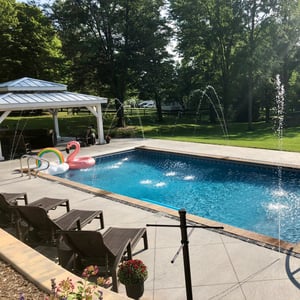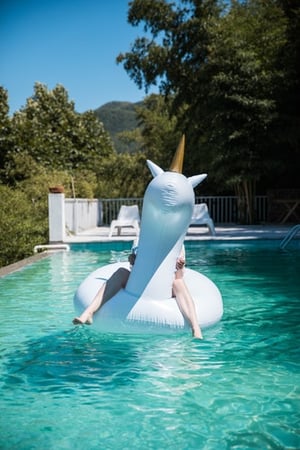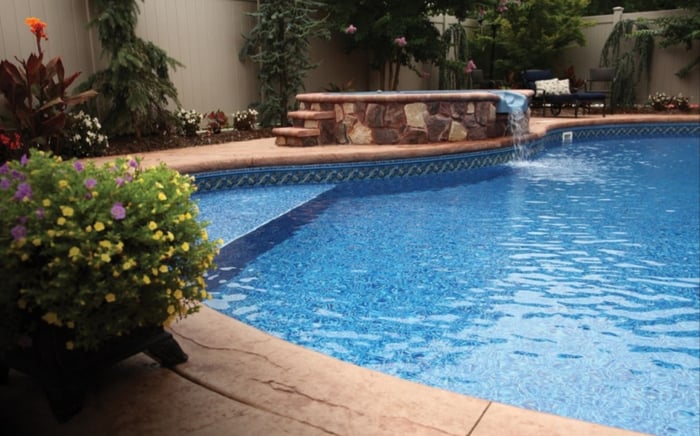So, you have or are considering a saltwater pool. That's great! Some of the benefits of these pool types are that salt water pools require less handling of harsh chemicals such as chlorine. Not only is the saltwater better for your skin, hair, and clothes but it's also eliminates the rise and drops in chlorine levels when shocking the pool. First and most importantly, install a sacrificial anode on the equipment. This will help protect the metal components within your pool from the corrosives of the salt water. We recommend two anodes if you have a heater. One on each side of the heater to protect the copper heat exchange from being eroded away.
All that being said, it's only great if properly maintain so here are the things you need to do to keep your pool in the best condition.

Every Day
You should get into the habit of checking your pool, yes, every single day even if it's just a quick looksie to make sure everything is okay. . You should:
- Quickly skim off any visible debris in the pool.
- Make sure that the skimmer is clear and empty the pump basket.
Once a Week
At least twice a week, you need to clean your pool. If you have an uncovered pool in a heavily treed area, or one in high use, you may need to do so more often.
- Net the surface to remove leaves and debris.
- Run a pool vacuum. Allow about 45 minutes to an hour to do this by hand or save yourself time by investing in an automatic pool cleaner.
- Check that the pump and filter are running correctly.
- Check the water chemistry and balance as needed. Use test strips or a drop kit to ensure that the pH is in the ideal range and that the free chlorine level is correct (remember, salt water pool generate their own natural chlorine) - it should be 1 to 3 ppm. you can add sodium carbonate better known as soda ash. If it's too high, use muratic acid and sodium bicarbonate to normalize the alkalinity and pH levels. If you are in doubt, contact a professional pool cleaner or check with the manufacturer.
- Rise off the pump, filter, and skimmer with the garden hose.
Once a Month
You should test and check some additional levels every month
- Salt levels should be checked to make sure they are within the range specified by the manufacturer. They can be increased simply by adding more salt. Try not to rely on the salt chlorinator's automatic reading. The salinity level should be between 3000 and 3500 ppm. This can also be checked by using a saltwater test kit.
- Stabilizer levels should be be 70-80 ppm for an outdoor pool and 0-30 ppm for indoor. If they are too high, add fresh water. If too low, add cyanuric acid.
- Calcium should be 200 to 400 ppm. High calcium keeps the pool from becoming cloudy where as low calcium will cause etching in plastered pools.
Every Three Months-2.jpeg?width=300&name=WON%20Marty%20Sheedy%201%20(2)-2.jpeg)
Manufacturers recommend that you inspect the salt cell every three months. Your chlorinator generally has an alert.
- Remove the salt cell and visually inspect for scale buildup or debris.
- If you see any deposits, flush the cell with a high-pressure garden hose. If that doesn't work, scrape it with plastic or wood. The last resort is a mild acid wash (4 : 1 ratio of water to muriatic acid). Always add the acid to the water, not the other way around. Soak the cell in the acid for a few minutes, then rinse it with your hose.
- Once the cell is checked and/or cleaned, reinstall it.
At the End of the Swim Season
It is vital to correctly close and winterize your pool at the end of the swimming season.
- Test the water remaining in the pool and adjust the chemistry as necessary. This might not seem important, but it creates the best environment for winterizing.See more on general winterizing here.
- Use a pool closing kit to help prevent algae and cloudy water. Winterizing kits normally consist of shock, algaecide, and metal remover. In warmer climates, it is particularly important to use an algaecide. Cleaning out algae from your pool is not fun.
- Remove the flow switch and salt cell and store them indoors. Use a dummy salt cell in it's place if you plan on leaving the pool running over the winter. Another form of chlorine will need to be used. Set the salt chlorine generator to winter or neutral. This is a good time to clean the salt cell.
- Drain the water from the pool's plumbing system. If you can't drain it completely, fill the skimmer with antifreeze.
- Thoroughly clean and brush the pool itself.
- Drain the water level just enough to allow the cover to be deployed. Remove any pool accessories that can be removed and cover any that can't.
- Clean the pool cover prior to deploying it. If you have leaves overlooking the pool, consider adding a leaf net.
- Shut off the breaker the pump at the main control panel.
At the Start of the Swim Season
When opening your pool for the season, do the following:
- Add fresh water to the pool to bring the water level to its normal range before starting the system. Turn on breaker to the pool devices. Test that your system is working before removing the cover.
- Remove any skimmer freeze protection devices.
- Clean and remove the pool cover. Clean all of the debris off the pool cover before removing it, so as to make sure that nothing drops into the pool. Some covers may need to have collected water drained off.
- Clean the pool thoroughly. Check that there are no metals in the water when you add new water.
- Test the pool's water chemistry. You will probably need to add pool salt. You should run the pump for at least 12 hours without the chlorine generator turned on. Turn it on only when you are happy with the chemistry levels.
- Metals such as iron and copper can cause corrosion.
- Inspect your zinc anode if you have one. A sacrificial zinc anode is used to protect pool hardware against corrosion. It should be checked every year to see if it has fully corroded, and the start of the season is the best time to do this.
- Inspect handrails and ladders for damage. If you have a diving board, inspect it and the stand, and make sure the surface has not lost its grip.
After a Major Party
If you have just thrown a pool party, consider the following:
- You may want to shock (super chlorinate) the pool before and after a large event. Check that the pool water is not cloudy. If it's cloudy test and stabilize the PH if it's out of range. Then use calcium hypochlorite shock powder. Do it early in the morning, and keep everyone out of the pool until the level has dropped below 5 ppm. You should also do this if your pool has algae in it.
- Brush and vacuum the pool and run the pool cleaner if applicable.
- Clean and rinse pool floats and toys.
Some of the steps for maintaining your salt water pool are the same as with any pool, some are different, however, it is still important to do all of your pool maintenance to keep everyone safe and healthy.
Here are some additional pool maintenance resources to help keep your pool crystal clear!
- Finally! An Easy Solution to Pool Maintenance
- The perfect solution for your saltwater pool: Pepper!
- Chlorine vs. Saltwater vs. Mineral System Pools: Pros and Cons
- How to clear a murky green pool fast with Revive
- How to Maintain a Saltwater Swimming Pool
- How to Convert a Chlorine Pool to a Saltwater Pool
- How To Troubleshoot Problems with Your Salt Cell
- Type of Salt to Use with a Swimming Pool Salt System
- Saltwater Above Ground Pools: A Buyer’s Guide
- How To Clean the Salt Cell on Your Saltwater Swimming Pool
- What is the Benefit of Switching to Salt Water?








